 W
WA bridge castle is a type of castle that was built to provide military observation and security for a river crossing. In the narrower sense it refers to castles that are built directly on or next to a bridge. Sometimes, however, castles close to a bridge are referred to as bridge castles.
 W
WA burgstall is a German term referring to a castle of which so little is left that its appearance cannot effectively be reconstructed. It has no direct equivalent in English, but may be loosely translated as "castle site". Variations in the literature include Burgstelle, Altburgstelle, die Burgställe (plural), Burgstähl (archaic) or abgegangene Burg. In German castle studies, a burgstall is a castle that has effectively been levelled, whereas a "ruin" (Ruine) still has recognisable remnants of the original castle above the level of the ground.
 W
WIn the Roman Republic and the Roman Empire, the Latin word castrum was a building, or plot of land, used as a fortified military camp. In English, the terms 'Roman fort', 'Roman camp' and 'Roman fortress' are commonly used for castrum. However, scholastic convention tends toward the use of the words 'fort', 'camp', 'marching camp' and 'fortress' as a translation of castrum.
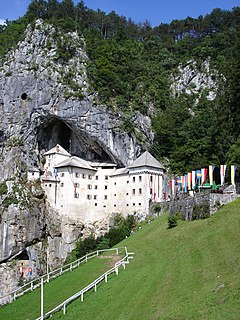 W
WA cave castle or grotto castle is a residential or refuge castle that has been built into a natural cave. It falls within the category of hill castles. Unlike other types, such castles can only be assaulted from the front, or by drilling through the rock above; the gateway is usually located in the middle of a rock face, which makes it much more difficult to penetrate. Archaeological discoveries have revealed that caves were used as places of refuge as early as the Stone Age. The first medieval cave castles emerged in the 11th and 12th centuries. In the 14th and 15th centuries this type became more widespread, especially in certain parts of France and Switzerland.
 W
WA coercion castle or coercive castle was a heavily fortified, medieval castle built to dominate the surrounding land. Such castles were built mainly in the High and Late Middle Ages in order to protect those territories in areas where the population was not assessed as being entirely loyal to the sovereign. Because of the poor infrastructure of medieval Europe, the construction of castles was one of the most important ways of exercising power, which is why it was governed by royal rights. Examples of coercive castles are the Moritzburg in Halle, which was built in the late 15th century, and the Alte Burg in Koblenz.
 W
WA concentric castle is a castle with two or more concentric curtain walls, such that the inner wall is higher than the outer and can be defended from it. The layout was square where the terrain permitted, or an irregular polygon where curtain walls of a spur castle followed the contours of a hill.
 W
WCounter-castles were built in the Middle Ages to counter the power of a hostile neighbour or as a siege castle, that is, a fortified base from which attacks could be launched on a nearby enemy castle.
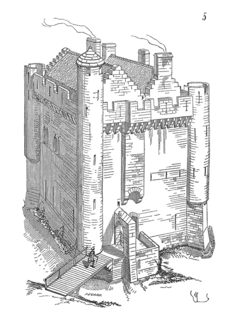 W
WA fortified house is a type of building which developed in Europe during the Middle Ages. Generally fortifications added.
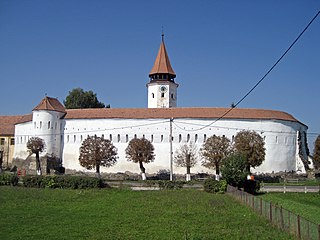 W
WA fortress church is a particular type of church that, in addition to its religious functions is also used by the local population as a retreat and defensive position, similar to a refuge castle. A fortress church usually implies that the church is enclosed by its own fortifications, such as curtain walls and defensive towers. By comparison, a church with simple defensive features, such as battlements and embrasures on the church itself, is usually just referred to as a fortified church.
 W
WA hillside castle is a castle built on the side of a hill above much of the surrounding terrain but below the summit itself. It is thus a type of hill castle and emerged in Europe in the second half of the 11th century. As a result of the particular danger to the site from attacks on the castle from the rising ground above it, this weak point is usually strongly protected by a shield wall or a Bergfried. Often a combination of these two passive defensive works were used.
 W
WA hilltop castle is a type of hill castle that was built on the summit of a hill or mountain. The chief advantage of such a strategically selected site was its inaccessibility. The steep flanks of the hill made assaults on the castle difficult or, depending on the terrain, even impossible. In addition, it often commanded excellent fields of view and fire over the surrounding countryside. The sheer height of the castle above the local area could also protect the occupants of the castle from bombardment. In addition, the prominent location of such a castle enhanced its status as a residence.
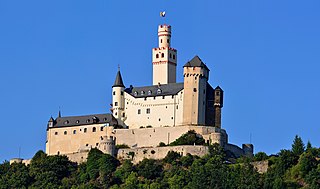 W
WA hill castle is a castle built on a natural feature that stands above the surrounding terrain. It is a term derived from the German Höhenburg used in categorising castle sites by their topographical location. Hill castles are thus distinguished from lowland castles (Niederungsburgen).
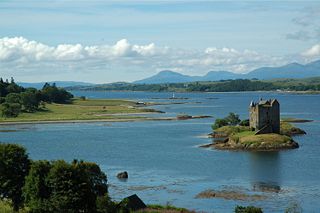 W
WThe island castle is a variation of the water castle. It is distinguished by its location on an artificial or natural island. It is a typical lowland castle.
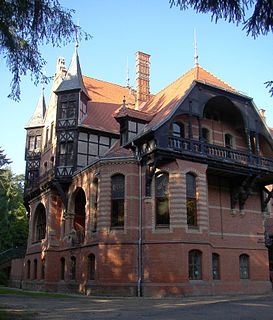 W
WJagdschloss is the German term for a hunting lodge. It is a schloss set in a wildlife park or a hunting area that served primarily as accommodation for a ruler or aristocrat and his entourage while hunting in the area.
 W
WJapanese castles were fortresses constructed primarily of wood and stone. They evolved from the wooden stockades of earlier centuries, and came into their best-known form in the 16th century. Castles in Japan were built to guard important or strategic sites, such as ports, river crossings, or crossroads, and almost always incorporated the landscape into their defenses.
 W
WA Jugendburg, sometimes referred to in English as a youth castle, is a mediaeval castle in German-speaking countries that was converted during the 20th century into a public community centre or educational facility for young people. The sponsors of the original youth castles came mainly from the Wandervogel and Pfadfinder movement, or were at least linked to the youth movement.
 W
WA kasbah, or variant spelling casbah or qasbah in English, also known as qasaba, gasaba and quasabeh, in India qassabah, in Portuguese alcáçova, and in Spain alcazaba, is a type of medina or fortress (citadel). The meaning of the word kasbah is varied, including "keep", "old city" and "watchtower" or "blockhouse".
 W
WKotta mara is a type of floating battery or fortified raft from Borneo. It is used by native Bornean in warfare, its usage rose prominently during the Banjarmasin war (1859-1906). Kotta mara is used in riverine warfare, as an armed vessel or simply a blockhouse or fortification to prevent enemy advance in the river.
 W
WAn L-plan castle is a castle or tower house in the shape of an L, typically built from the 13th to the 17th century. This design is found quite frequently in Scotland, but is also seen in England, Ireland, Romania, Sardinia, and other locations. The evolution of its design was an expansion of the blockhouse or simple square tower from the Early Middle Ages. As building techniques improved, it became possible to construct a larger building footprint and a more complex shape than the simple blockhouse tower. A more compelling motivation for the L plan was the ability to defend the entrance door by providing covering fire from the adjacent walls. This stratagem was particularly driven by the advent of cannon used by attackers.
 W
WA Landesburg or landesherrliche Burg was a castle that a territorial lord, such as a prince-bishop, duke or prince built for the defence or expansion of his sovereign estates. They were thus the central and most important castles of the great princely territories. The Landesburgen were usually the property of the territorial lord, but they sometimes referred to castles that he did not own, but were available to him as a safe house (Offenhaus). The large castles of the 8th to 10th centuries, east of the Rhine and outside the towns were often described as Landesburgen because they performed important functions in the control of the state.
 W
WA Letzi or Letzimauer refers to defensive barriers whose purpose is to protect the entrance into a valley. The term is Swiss, and such stone barriers were particularly common in medieval Switzerland but were also built in Austria and Germany.
 W
WThe term lowland castle or plains castle describes a type of castle that is situated on a lowland, plain or valley floor, as opposed to one built on higher ground such as a hill spur. The classification is extensively used in Germany where about 34 percent of all castles are of the lowland type.
 W
WIn Renaissance and Early Modern German architecture, a Lustschloss is a small palace which served the private pleasure of its owner, usually the ruler of the area it is located in, and was seasonally inhabited as a respite from court ceremonies and state duties. In France, the château de Madrid in the Bois de Boulogne, easily reached from Paris, set an example, and Louis XIV similarly retreated from onerous ceremonial at Versailles to his château of Marly.
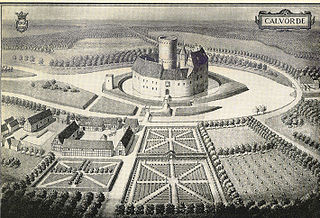 W
WA marsh or marshland castle is a type of lowland castle that is situated in marshy or boggy countryside. It uses the natural inaccessibility of the terrain to its defensive advantage.
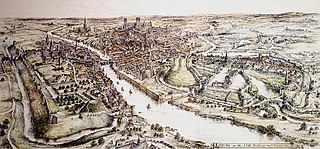 W
WA motte-and-bailey castle is a fortification with a wooden or stone keep situated on a raised area of ground called a motte, accompanied by a walled courtyard, or bailey, surrounded by a protective ditch and palisade. Relatively easy to build with unskilled labour, but still militarily formidable, these castles were built across northern Europe from the 10th century onwards, spreading from Normandy and Anjou in France, into the Holy Roman Empire in the 11th century. The Normans introduced the design into England and Wales following their invasion in 1066. Motte-and-bailey castles were adopted in Scotland, Ireland, the Low Countries and Denmark in the 12th and 13th centuries. Windsor Castle, in England, is an example of a motte-and-bailey castle. By the end of the 13th century, the design was largely superseded by alternative forms of fortification, but the earthworks remain a prominent feature in many countries.
 W
WOstrog is a Russian term for a small fort, typically wooden and often non-permanently manned. Ostrogs were encircled by 4–6 metres high palisade walls made from sharpened trunks. The name derives from the Russian word строгать (strogat'), "to shave the wood". Ostrogs were smaller and exclusively military forts, compared to larger kremlins that were the cores of Russian cities. Ostrogs were often built in remote areas or within the fortification lines, such as the Great Abatis Line.
 W
WThe word qalat (kalata) is Persian and qal'at (wiktionary:قلعة) is Arabic for 'fortified place'. It frequently occurs in place names. Qalats can range from castles like Rumkale to the mud-brick compound common throughout southwest Asia. The term is used throughout the Muslim world to indicate a defensive fortress. It is even preserved in place names in places such as Sicily, which was occupied by the Aghlabid dynasty and then the Fatimids from the ninth to the twelfth centuries.
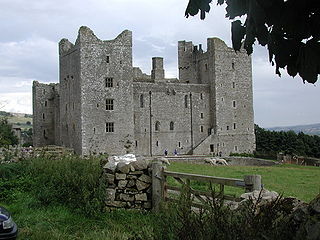 W
WA quadrangular castle or courtyard castle is a type of castle characterised by ranges of buildings which are integral with the curtain walls, enclosing a central ward or quadrangle, and typically with angle towers. There is no keep and frequently no distinct gatehouse. The quadrangular form predominantly dates from the mid to late fourteenth century and signals the transition from defensively to domestically oriented great houses. The four walls are also known as ranges.
 W
WA refuge castle or refuge fort is a castle-like defensive location, usually surrounded by ramparts, that is not permanently occupied but acts as a temporary retreat for the local population when threatened by war or attack. In former times such sites were also described as giant castles because their origin was ascribed to giants.
 W
WA ridge castle is a medieval fortification built on a ridge or the crest of mountain or hill chain.
 W
WA ringwork is a form of fortified defensive structure, usually circular or oval in shape. Ringworks are essentially motte-and-bailey castles minus the motte. Defences were usually earthworks in the form of a ditch and bank surrounding the site.
 W
WA rock castle is a type of medieval castle that directly incorporates natural rock outcrops into its defences to such an extent that the rock formations define the structure of the castle. Topographically, rock castles are classified as hill castles.
 W
WA spur castle is a type of medieval fortification that uses its location for defense. The name refers to a spur from a hill or mountain. Ideally, a it would be defended on three sides by steep hillsides, with the only vulnerable side that where the spur joins the hill or escarpment.
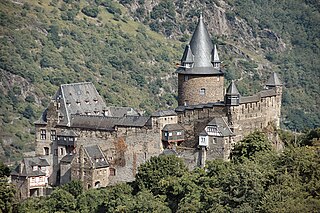 W
WA toll castle is a castle that, in the Middle Ages and the Early Modern Era, guarded a customs post and was intended to control it. They were typically found in the Holy Roman Empire. Toll castles always stood in the vicinity of an important long-distance trade route over, for example, the Alpine passes or the Middle Rhine. Such castles were usually placed at strategic locations, such as border crossings, river crossings or mountain passes, and were manned by armed guards. The actual toll-collecting point lay below at the road or river and was often linked by walls to the castle itself.
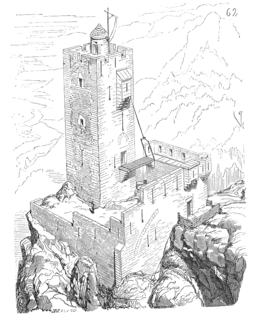 W
WA tower castle is a small castle that mainly consists of a fortified tower or a tower-like structure that is built on natural ground. It is thus different from the motte-and-bailey castle, which it may resemble, but whose main defensive structure is built on a motte or artificial hill. The tower castle is occasionally also described as a tower house castle or a tower house.
 W
WA tulou, or "earthen building", is a traditional communal Hakka people residence found in Fujian, in South China, usually of a circular configuration surrounding a central shrine, and part of Hakka architecture. These vernacular structures were occupied by clan groups.
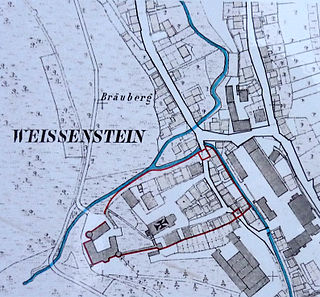 W
WAn urban castle is a castle that is located within a medieval town or city or is integrated into its fortifications.
 W
WA water castle is a castle or stately home whose site is entirely surrounded by water-filled moats or natural waterbodies such as island castles in a river or offshore.
 W
WZ-plan is a form of castle design common in England and Scotland. The Z-plan castle has a strong central rectangular tower with smaller towers attached at diagonally opposite corners.